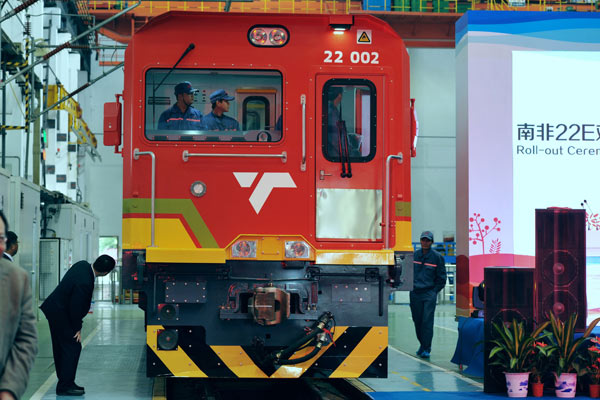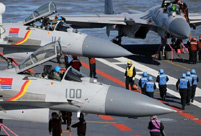


An electric locomotive bound for export to South Africa comes off the production line in Zhuzhou, Hunan province. [Photo/Xinhua]
Aviation, transport and telecoms sectors get renewed impetus
China expects to export more aviation, transportation and telecommunications technology and products this year, and continue with an industrial upgrade at home, the Ministry of Commerce said on Monday.
Zhi Luxun, deputy director-general of the ministry's department of foreign trade, said core to the export policy remains transforming from being a low-grade consumer-goods manufacturer to one producing higher value added products, while maintaining stable domestic economic growth.
Exports of China's rail transportation and aviation technology sectors, as well as its machine tools and rail industries, grew between 15 percent and 30 percent in 2015.
At the same time, the country's telecommunications and power-equipment industries expanded their presence in 140 countries and regions, including highly developed markets such as the European Union and the United States.
"The country's fast-growing 4G telecom networks and the Made in China 2025 strategy will further lead to improvements in productivity and resource efficiency this year," said Zhi.
"The potential benefits are even greater if they are extended to every stage of the value chain, from suppliers and manufacturers through to customers."
Shi Ziming, deputy director-general of the ministry's department of outward investment and economic cooperation, said China's rapid ongoing urbanization process has caused labor-intensive industries to struggle as they face a myriad of difficulties, such as high staff turnover, especially in the country's computer, communication and consumer electronics product manufacturing sectors.
By combining global market demand, China has gradually shifted its focus onto high-end industrial research and development, which has delivered strong technical breakthroughs in high-tech sectors such as offshore engineering, robotics, computers, communication and in upgraded consumer electronics products.
Shi said the Belt and Road Initiative will boost China's exports of high-speed rail technology and related products-now considered the country's pillar products for high-end product export-as a number of nations, especially Southeast Asian countries look to enhance their economic growth via modern transportation networks.
The initiative, proposed by China in 2013, is a trade and infrastructure network that includes the Silk Road Economic Belt and the 21st Century Maritime Silk Road. The planned network connects Asia, Europe and Africa and passes through more than 60 countries and regions.
China started construction on Indonesia's first high-speed railroad project last week, which stretches from the capital Jakarta to the city of Bandung.
The government now hopes the move will encourage more Southeast Asian countries to upgrade their rail systems.
The Asian Development Bank said recently that the proportion of China's high-end product exports surged from 9.4 percent of Asia's total annual exports in the category in 2000, to 43.7 percent in 2014.
 A foreign girl explains what China should be proud of
A foreign girl explains what China should be proud of Chinese navy's air-cushioned landing craft in pictures
Chinese navy's air-cushioned landing craft in pictures Chinese pole dancing master opens class in Tianjin
Chinese pole dancing master opens class in Tianjin PLA holds joint air-ground military drill
PLA holds joint air-ground military drill Charming female soldiers on Xisha Islands
Charming female soldiers on Xisha Islands Beautiful skiers wear shorts in snow
Beautiful skiers wear shorts in snow Getting close to the crew on China's aircraft carrier
Getting close to the crew on China's aircraft carrier Chinese stewardess celebrate test flight at Nansha Islands
Chinese stewardess celebrate test flight at Nansha Islands Pentagonal Mart becomes the largest vacant building in Shanghai
Pentagonal Mart becomes the largest vacant building in Shanghai Top 20 hottest women in the world in 2014
Top 20 hottest women in the world in 2014 Top 10 hardest languages to learn
Top 10 hardest languages to learn 10 Chinese female stars with most beautiful faces
10 Chinese female stars with most beautiful faces China’s Top 10 Unique Bridges, Highways and Roads
China’s Top 10 Unique Bridges, Highways and Roads ‘The Monkey King’ sequel leaps ahead of original
‘The Monkey King’ sequel leaps ahead of original Snow my God! Fun times during China’s deep freeze
Snow my God! Fun times during China’s deep freeze Telecom scammers cheat victims out of thousands of yuan
Telecom scammers cheat victims out of thousands of yuan Homeless people try to survive subzero temperatures in Beijing
Homeless people try to survive subzero temperatures in BeijingDay|Week